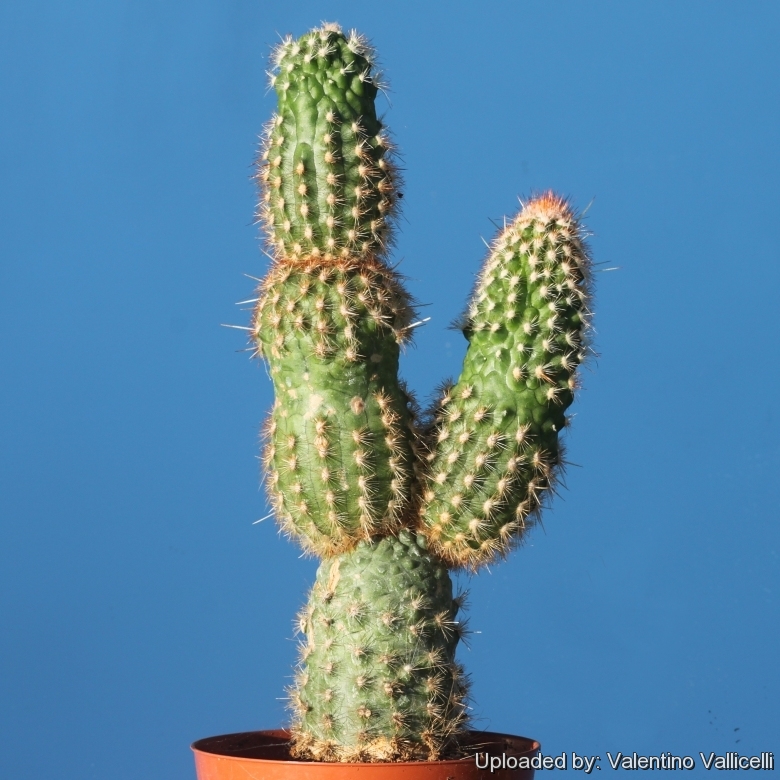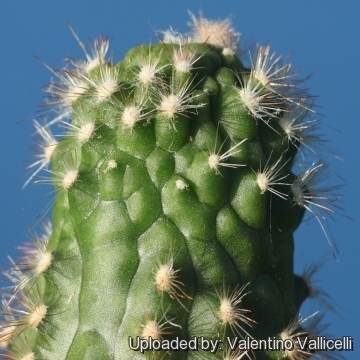= Espostoa guentheri f. monstruosa hort.
Accepted Scientific Name: Espostoa guentheri (Kupper) Buxb.
Oesterr. Bot. Z. 106: 155. 1959 nom. inval.

Vatricania guentheri f. monstruosa (Espostoa guentheri f. monstruosa) Photo by: Valentino Vallicelli
Origin and Habitat: Garden origin (Nursery produced cultivar)
Synonyms:
See all synonyms of Espostoa guentheri
back
Accepted name in llifle Database:Espostoa guentheri (Kupper) Buxb.Oesterr. Bot. Z. 106: 155. 1959 nom. inval.Synonymy: 12
back
Description: This is a monstrous form with stems constricted in irregular segments. The ribs structure varies from part to part of the stems, in some areas the ribs are almost normal, vertical with standard spiny areoles, while in other places the ribs disappear and the surface is formed by flattened, polygonal, spineles, tubercles, whit transitional parts between.
The standard Espostoa guentheriSN|6818]]SN|6818]] (Vatricania) is a shrubby columnar cactus with attractive golden-spined stems that exhibit varying densities of lateral cephalia; that is, beds of woolly hairs grow on the sides of the branches from which comes flowers and fruits. It grows in habitat to about 2 m high and will branch in age from the base. This species was placed in its own genus Vatricania because it occurs in eastern Bolivia whereas all the Espostoas occur in Peru.
Stems: Pale green, erect, up to 2(-3) m tall and 10 cm in diameter.
Ribs: 27, barely tuberculate.
Areoles: Yellowish white, woolly, spaced about 1 cm on the rib.
Spines: 15-25 spines, 5-22 mm long straw yellow to reddish.
Cephalium: Lateral up to to 50 cm long, and 6-7 cm thick, brownish, with reddish-brown to grey wool, reddish bristles and many spines 4-6 cm long. The cephalium, which is a zone of long, fine spines, first occurs superficially on one side of the stem but eventually grows to completely encircle the top of the plant often making them resemble elongated leeches. This can he achieved in a glasshouse but takes many years since the plant tends to he slow growing in cultivation. The cephalium is often oriented in only one direction, but now and then different branches will have cephalia facing in different directions. Given that this species inhabits proximity to the equator, where there is no evident advantage to orientation in any particular direction.
Flowers: Campanulate to tubular, yellowish or whitish up to 8 cm long, 2,5-3 cm in diameter pericarpels and floral tubes with fine pinkish wool.
Fruits: Roundish, scaly edible but not particularly tasty or sweet of odd texture and a flavour that ranges from indifferent to strange.
Blooming period: The flowers come in early summer.
Subspecies, varieties, forms and cultivars of plants belonging to the Espostoa guentheri group
Bibliography: Major references and further lectures.
1) Lowry, M. 2013. Espostoa guentheri. In: IUCN 2013. "IUCN Red List of Threatened Species." Version 2013.2. <www.iucnredlist.org>. Downloaded on 23 March 2014.
2) Edward Anderson “The Cactus family” Timber Press, Incorporated, 2001
3) James Cullen, Sabina G. Knees, H. Suzanne Cubey "The European Garden Flora Flowering Plants: A Manual for the Identification of Plants Cultivated in Europe, Both Out-of-Doors and Under Glass" Cambridge University Press, 11/Aug/2011
4) David R Hunt; Nigel P Taylor; Graham Charles; International Cactaceae Systematics Group. "The New Cactus Lexicon" dh books, 2006
5) Backeberg, C "Die Cactaceae" volumes IV, VI. Fischer-Verlag, Jena, Germany 1960
6) Kranz, H. Die Kakteen Lieferung 33, Stuttgart, Germany 1966
7) Kupper, W. "Cephalocereus guentheri n.sp." in: Monatschrift der DKG 3:159, Berlin, Germany 1931
8)Rritter, F. "Kakteen in Südamerika" volume 2 Self-Published 1980
 Vatricania guentheri f. monstruosa (Espostoa guentheri f. monstruosa) Photo by: Valentino Vallicelli
Vatricania guentheri f. monstruosa (Espostoa guentheri f. monstruosa) Photo by: Valentino Vallicelli Vatricania guentheri f. monstruosa (Espostoa guentheri f. monstruosa) Photo by: Valentino Vallicelli
Vatricania guentheri f. monstruosa (Espostoa guentheri f. monstruosa) Photo by: Valentino VallicelliCultivation and Propagation: It is easy to grow. Need a fertile, well drained soil mix. Water the plants well and allow them to dry before watering again. This species seems to do better with a little more water than most cacti. During the growing season fertilize them monthly with a balanced fertilizer. Espostoa produces noticeable amounts of growth each year if kept well fed and watered throughout the warmest months, particularly if it has been acclimatised to accept full sun.
Sun Exposure: Outside full sun, inside needs bright light, and some direct sun.
Winter rest: During winter month, put them in a cool luminous place and encourage them to enter winter dormancy by withholding water and fertiliser over the winter as they will etiolate, or become thin, due to lower levels of light. It is hard as low as 0 °C (or less) but it is best a warm habitat means that a minimum of 10°C should be maintained to avoid marking of the stem.
Pests and disease: They are susceptible to fungal diseases if overwatered, but are not nearly as sensitive as many other cacti, especially in warm weather. If kept damp through cold periods, they will invariably suffer.
Propagation: Cutting or from seed. The seeds are quite easy to germinate and grow. Their main requirements consist of high humidity levels, free-draining soil mix, and enough water, light, and nutrition.












